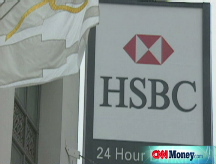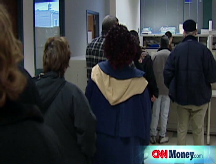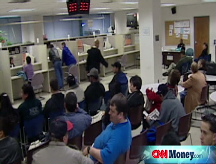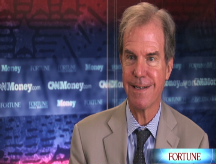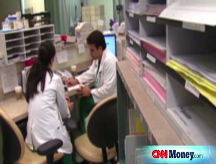Lending rate ticks lower
The overnight bank-to-bank lending rate falls to a record low, even though the 3-month rate held steady. Government debt prices lower.
NEW YORK (CNNMoney.com) -- Credit markets showed more signs of improvement Monday as one short-term bank-to-bank lending rate fell to a record low.
Government debt prices churned, but remained at elevated levels and still expressed market uncertainty.
The overnight Libor rate fell for the sixth day in a row Monday to 0.19%, according to the British Bankers' Association, pushing below the record low 0.28% set Friday. The 0.19% rate was the overnight Libor's lowest level on record, according to the BBA.
The longer term bank-to-bank lending rate, however, held steady for the third day running. The 3-month Libor rate was 2.19% Monday, according to data from Bloomberg.com, holding even with its levels on Thursday and Friday.
Libor, the London Interbank Offered Rate, is a daily average of what 16 different banks charge other banks to lend money in London, and is used to calculate adjustable-rate mortgages. More than $350 trillion in assets are tied to Libor.
One analyst said that the decline in the overnight Libor rate was a sign that the credit markets are improving. While the 3-month Libor rate has been slower to come down, the overnight Libor rate is a more immediate indicator of the credit markets.
"The shorter terms are the most indicative of liquidity in the credit markets," said Mary Ann Hurley, vice president of fixed income trading at D.A. Davidson. One of the primary reasons the short-term rates are lower is because of aggressive rate cuts by central banks across the globe.
A slew of European Central banks slashed their key interest rates last week. The European Central Bank, Bank of England and the Swedish Riksbank all announced interest rate cuts in order to spur economic activity.
The U.S. central bank has been the most aggressive in cutting interest rates. But with the key lending rate at 1%, the Federal Reserve has only a limited amount of leverage available in the economy with the interest rate cuts.
One policy mentioned by Fed Chairmen Ben Bernanke was the Federal Reserve buying its own debt as a way to add liquidity to the financial system.
Even as the balance sheets of banks return to health, however, the health of the U.S. consumer affects the credit markets. The Federal Reserve said Friday that consumer borrowing fell by $3.6 billion in October to $2.578 trillion, as strapped consumers adhere tightly to budgets.
"This economy is driven by consumer spending, and you take the consumer out or reduce what the consumer can do, and that is a major negative for the market," said Hurley.
Treasurys: Meanwhile, government debt prices churned, but remained very elevated Monday. In the last week, government debt prices hit record highs and yields hit record lows.
The record low yields indicate that investors consider the safe preservation of their capital more important than making a profit in the current market. As the stock market has been whipsawed in recent weeks with unprecedented volatility and the U.S. economy was officially declared in a recession, demand for the safety of government debt has been very strong.
Monday, however, investor sentiment was buoyed by a tentative agreement reached by key lawmakers to keep the auto industry's Big Three out of bankruptcy, at least for the short-term. The agreement would keep U.S. automakers afloat through March, until the new Congress and the Obama administration would be able to draft a more permanent solution.
Employers cut 533,000 jobs in November, according to a government report released Friday. November posted the largest monthly job loss total since December 1974, bringing the year's total job losses to 1.9 million. Friday, however, stocks erased early losses to end the day higher.
On Monday, stocks added to those gains.
With Wall Street rallying, the rush to purchase Treasurys slowed and prices of government debt were slightly lower.
President-elect Barack Obama said over the weekend that he would spend whatever is necessary on a stimulus program to resuscitate the U.S. economy. Obama's comments added to investor positive sentiment about the automakers.
Bond prices were weighed down by "the belief that the fiscal stimulus plan that is going to be submitted by the Obama administration is going to help kick start the economy, which is reducing the flight to quality a bit," said Hurley.
A massive stimulus program will cost a lot, and the flood of supply of government debt also worked to weigh on bond prices. On Monday, the government auctioned off $27 billion worth of 91-day bills and $27 billion worth of 182-day bills.
The price on the benchmark 10-year note fell 20/32 to 108-20/32 and its yield rose to 2.76% from 2.68% late Friday. Two weeks ago, the 10-year yield fell below 3% for the first time since the note was first issued in 1962. Bond prices and yields move in opposite directions.
The 30-year bond ticked down 23/32 to 125-24/32 and its yield rose to 3.15% from 3.11%. The yield on the long bond set record lows last week.
The 2-year note fell 2/32 to 100-18/32 and its yield rose to 0.96% from 0.94%.
The yield on the 3-month was 0.03%, up slightly from 0.02% Friday. That yield hovered very close to 0% for most of the session Thursday and approached the same level again Friday.
The 3-month bill is closely watched as an indicator of investor confidence. Investors and money-market funds shuffle funds in and out of the 3-month bill frequently, as they assess risk in the rest of the marketplace. A higher yield indicates that investors are slightly more optimistic.
Credit market gauges: Several credit market gauges were little changed from Friday.
The "TED spread" narrowed slightly to 2.16 percentage points from 2.17 percentage points Friday. The TED spread measures the difference between the 3-month Libor and the 3-month Treasury bill, and is a key indicator of risk. The higher the spread, the more unwilling investors are to take risks.
Another indicator, the Libor-OIS spread was 1.88 percentage points, unchanged from Friday. The Libor-OIS spread measures how much cash is available for lending between banks, and is used for determining lending rates. The bigger the spread, the less cash is available for lending. ![]()

